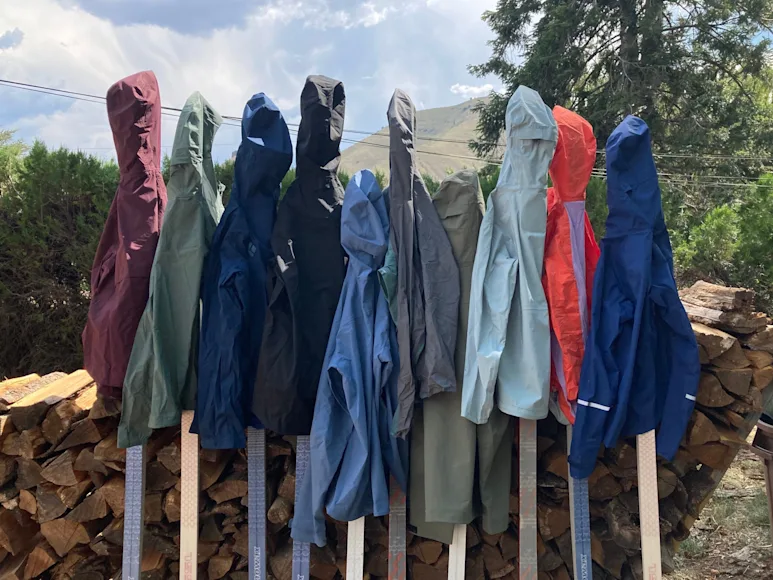_We may earn revenue from the products available on this page and participate in affiliate programs. Learn more ›
_
Best Overall

Houdini BFF Jacket
Best for Hunting
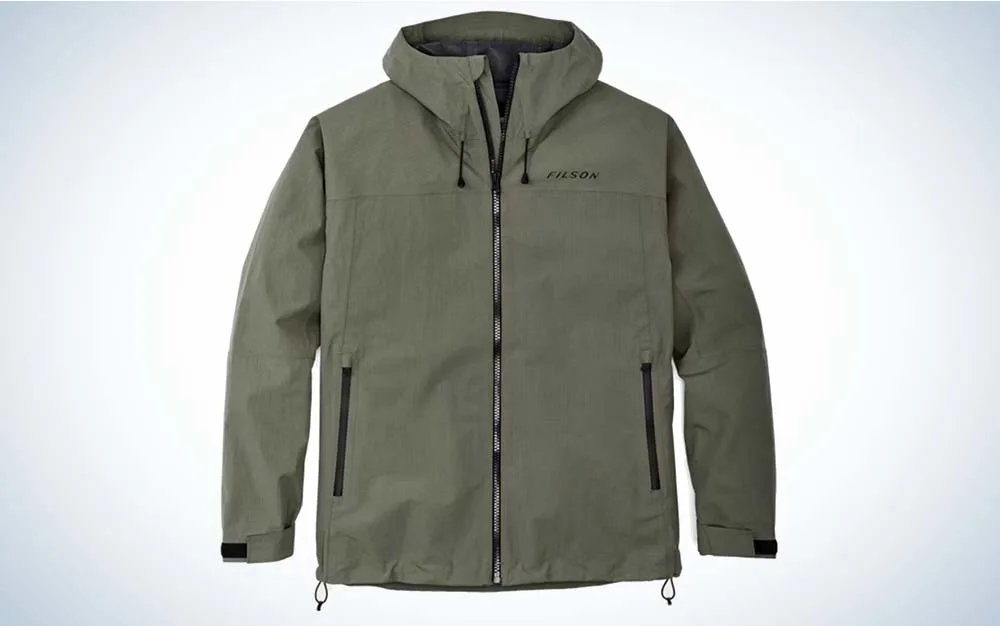
Filson Swiftwater Rain Jacket
Most Comfortable

Free Fly Cloudshield Rain Jacket
If you’re anything like me, you’re out on the trails, rain or shine. Some days, I even prefer hiking in the rain because it means more solitude. Regardless, even fair-weather hikers should carry a rain jacket when hiking in the mountains or other regions with frequent and sometimes unpredictable rainstorms. The best hiking jackets
differ from person to person and activity to activity—which is why I spent three months testing 10 of the most popular rain jackets to find which ones actually hold up in wet weather.
With the outdoor industry focusing more on phasing out harmful waterproofing materials like PFAS
, it was important for us to align our testing with brands that either have never utilized these materials or are, at the very least, actively working on replacing them with better and equally functional alternatives. While I can’t say any of these rain jackets are “perfect,” they are the best rain jackets in terms of durability and versatility that fit a variety of outdoor activities.
Best Overall: Houdini BFF Jacket
Best for Hunting: Filson Swiftwater Rain Jacket
Best Lightweight: Outdoor Vitals Tushar Rain Jacket
Best Quarter Zip: Black Diamond Stormline Stretch Anorak Rain Shell
**Most Packable: Jack Wolfskin PreLight 2.5L Rain Jacket
**
Most Comfortable: Free Fly Cloudshield Rain Jacket
How We Picked the Best Rain Jackets
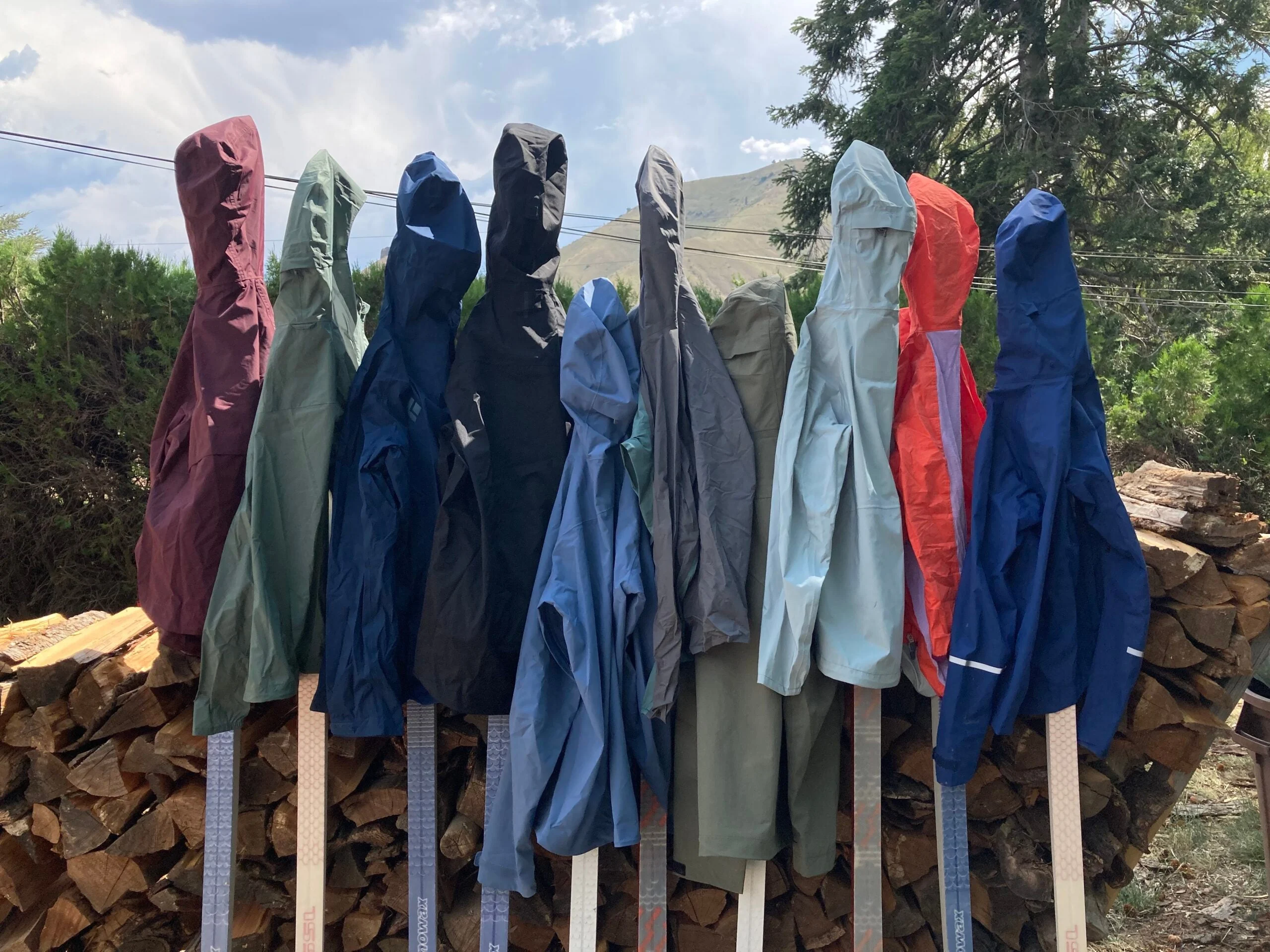
Not all the rain jackets we tested made the cut through our testing process, but that doesn’t mean they’re bad jackets. They still worked well enough. We just wished they would’ve worked a little bit better. – Meg Carney
Before my testing process started, I spent hours researching the best rain jackets and brands, chatting with brand representatives about materials and designs, and finally choosing rain jackets to test side by side. While I wore all of the jackets in real-world settings while hiking, paddling, and biking in the rain for various lengths of time, I also tested them using a hose and sprinkler system to get a truly uniform and comprehensive testing result. That way, I could accurately determine the varying saturation points, how well the jackets bead off the water, and if there were any points of failure in the designs.
Testing the jackets in real-world settings in the field was equally important to me to better analyze the comfort of the fit, overall mobility, and ventilation. Although I tested 10 jackets in total, not all made the cut, so you’ll see only six featured in the first edition of this roundup. Since I was primarily testing jackets based on functionality, the ones cut from the review were removed for reasons such as lack of ventilation, improper fit in the women’s designs, and inadequate waterproofing for outdoor activities.
We continually update our product reviews as more testing is conducted and other products that may be a better fit come onto our radar. So, check back for future updates on current product descriptions, reviews regarding durability, and potentially new product additions.
Best Rain Jackets: Reviews and Recommendations
Best Overall: Houdini BFF Jacket
Best Overall

Specs
Weight: 12 oz
Waterproofing: DWR finish – PFAS-free
Fabric: 70% Eco Circle recycled polyester, 30% polyester, Atmos, 100% polyester membrane
Breathability: 15,000 g
Waterproofness: 20,000 mm H2O or higher
Pit Zips: Yes
Pros
Made from recycled materials and recyclable
PFAS free waterproofing
Excellent coverage and protective features
Comfortable feel and fit (especially for women)
Quiet materials
Relatively lightweight for durability and performance
Cons
Price
When I first received this jacket, the feel of the fabric caught me off guard, and I was unsure the soft and quiet feel of the materials could hold up to heavy rain and snow. It seemed like it would be bulkier than some of the other options, and I wasn’t sure I was a fan of carrying those extra few ounces on trial. So, how did this one become my number one choice out of 10 fantastic rain jackets?
To my surprise, the Houdini BFF Rain Jacket stands up to its name and has quickly become my best friend on all my outdoor adventures. The fit is loose, but this is my preference, so I can utilize the jacket year-round in a layering system. The soft quiet feel of the fabric ended up being one of my favorite things because it didn’t crinkle or make noise as I hiked or did other activities. While hiking in the rain, ample ventilation is a must-have for my rain jackets. The Houdini BFF features a dual zipper system, under-arm zippers, and relatively breathable material.

Testing the Houdini BFF Rain Jacket in Central Washington. – Meg Carney
The Atmost Membrane used in the jacket design is a hydrophilic membrane meaning it is not microporous, but at the molecular level of the fabric, it moves moisture through the fabric away from your body. There is no other membrane I know of with the same performance level and environmentally sustainable materials in a rain jacket.
While the performance of the jacket held up to the standard, what blew me away about this jacket was Houdini’s dedication to sustainability.
Houdini follows a circular production model, which, according to the brand, means all of their products are made from recycled materials and are recyclable at the end of life, or they’re made from renewable and biodegradable materials. Additionally, the waterproof coating they’ve chosen for this jacket is PFAS-free.
If you’re looking for an all-around stylish and high-performing outdoor jacket that can be worn year-round, look no further than the Houdini BFF Rain Jacket.
Best for Hunting: Filson Swiftwater Rain Jacket
Best for Hunting

Specs
Weight: 13.4 oz
Waterproofing: DWR
Fabric: ripstop 100% recycled nylon w/ membrane
Breathability: 15,000 g
Waterproofness: 20,000 mm H2O
Pit Zips: No
Pros
Made from recycled materials
Durable ripstop nylon
Decent breathability
Available in both men’s and women’s cuts
Excellent for layering systems
Cons
Price
No underarm zippers
The Swiftwater Rain Jacket is Filson’s lightest rain jacket, and it’s the perfect weight and packability for backpacking or upland hunting. It fits true to size in both men’s and women’s sizing. Made from 100% recycled materials, Filson doesn’t compromise functionality, durability, or performance with this jacket. It isn’t stated whether or not the DWR coating is PFAS-free, so we assume that it isn’t. While that could be improved for future designs, the waterproof performance of the jacket is excellent.
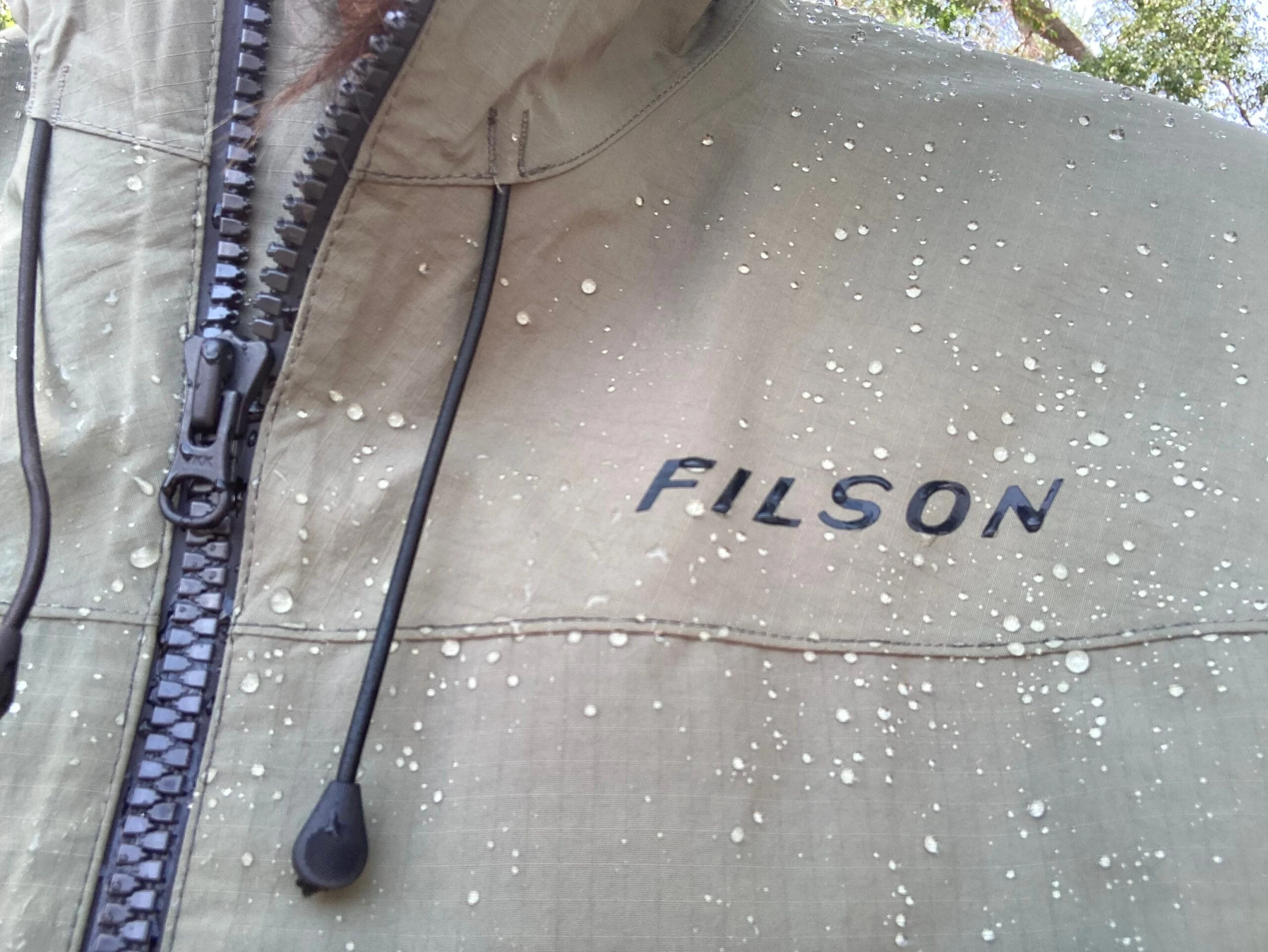
The Filson Swiftwater Rain Jacket is a durable waterproof option for anyone looking for heavy-duty weather protection. – Meg Carney
Whether you need a jacket for work, hunting, or daily wear, the design offers enough room for layering and decent breathability. It is a 2.5-layer fabric design with fully sealed seams which provides a high level of waterproofing but somewhat limits the breathability, especially without underarm zippers. Unlike Filson’s heavier waterproof jacket designs, the Swiftwater’s waterproof membrane’s microscopic pores allow some moisture and heat to escape, making it better for more active wearers.
The rain flap for the zipper is on the interior, and the water-resistant AquaGuard zippers from YKK ensure that the entire jacket is waterproof through and through. In terms of packability, it does an okay job. The thicker materials roll into the hood, making it small enough to stuff into a pack or vest. Overall, this is a stellar jacket. It offers a high level of protection against the elements along with most of the features hunters and anglers desire, and enough adjustability to make it a decent hunting jacket
.
Best Lightweight: Outdoor Vitals Tushar Rain Jacket
Best Lightweight
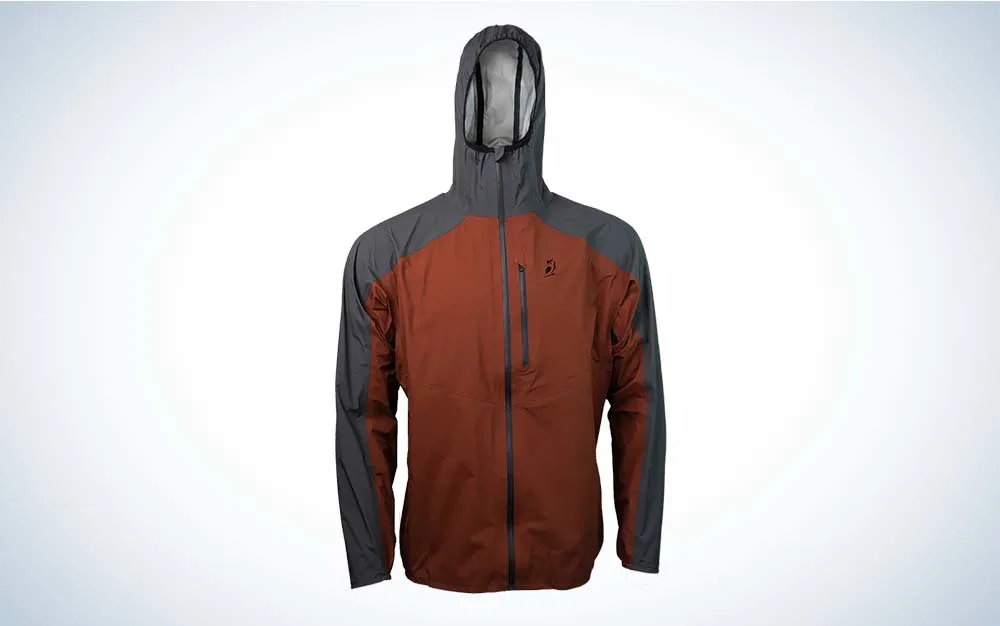
Specs
Weight: 7.4 oz
Waterproofing: Toray Torain 3D 2.5
Fabric: 20D micro-Ripstop nylon
Breathability: 20,000 g
Waterproofness: 28,500mm HH
Pit Zips: Yes
Pros
Packs down small
Excellent fit
Ideal ventilation features
Hydrophobic membrane at high-pressure points
High level of water resistance for the weight
Cons
Designed for ultralight activities, not for durability
Only available in men’s sizing
Outdoor Vitals offers a unique and innovative lightweight rain jacket design with its Tushar line. Only available in men’s sizing, I found that the fit still suits my body type, which was a pleasant surprise. To cut back on weight, there is a limited about of adjustability and pocket storage in this jacket, but sometimes less is more. With this jacket, I found that to be true. To rest the double laminated waterproofing of the Toray Torain technology, I put this jacket through rain storms and river rapids, and in all scenarios, it held up surprisingly well.
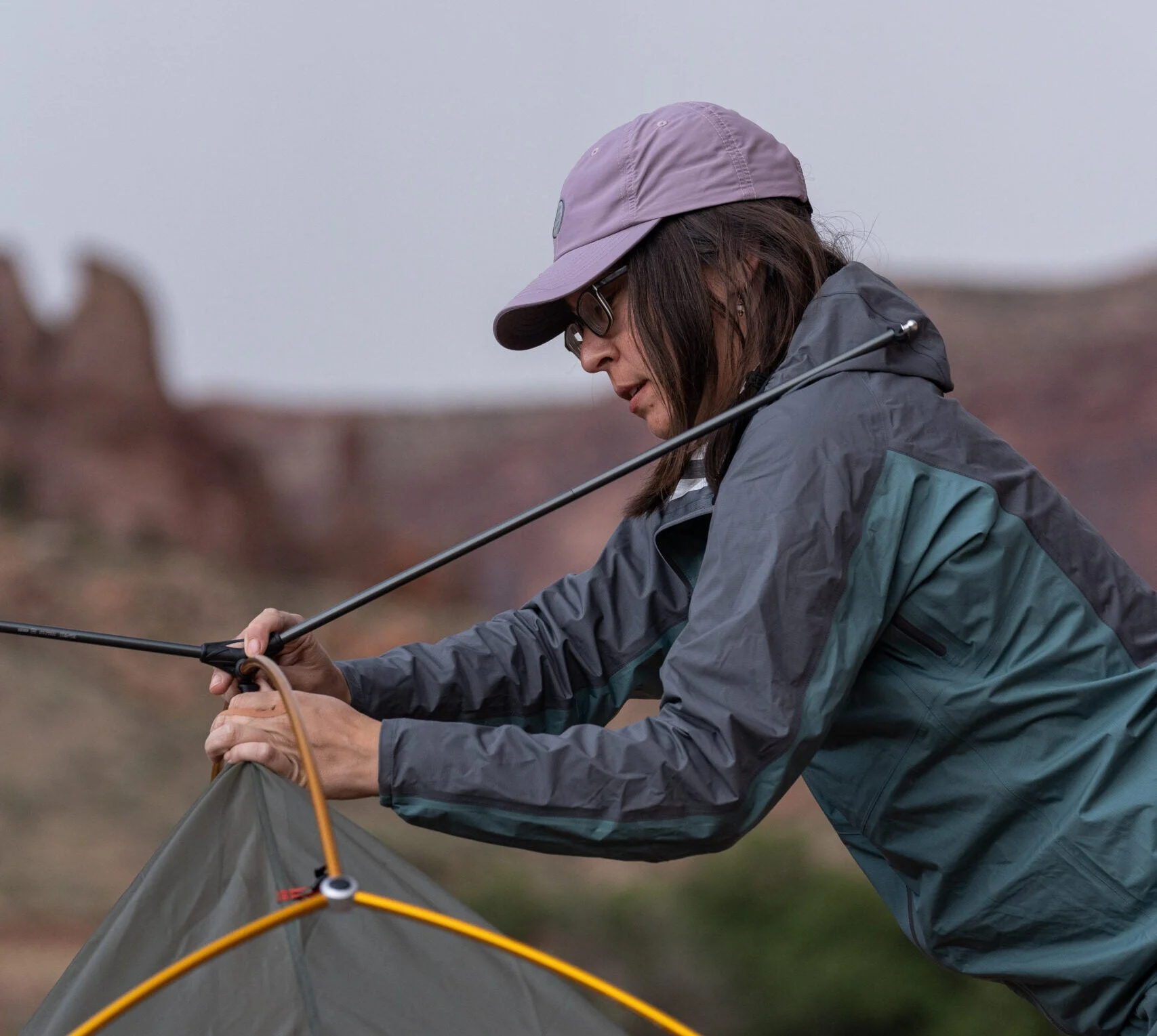
_Setting up camp before a rain storm in the Outdoor Vitals Tushar Rain Jacket in Moab, UT. – Photo Courtesy of Orijin Media
taken by Zach Montes_
The hood and the cuffs don’t offer velcro or drawstrings, but the elastic fit keeps most moisture out and the fabric in place while moving around. All seams are sealed with the Torain sealing technology for additional performance and increased durability. To stay a little drier while paddling white water and to see how it would fare in hot weather, I wore this jacket even on the flat water sections. While the materials do not appear very breathable, I didn’t get too warm with the underarm zippers open and I stayed relatively dry with the underarm zippers open.
This jacket was a top contender for the best overall award thanks to its performance, but what knocked it down a spot was the jacket’s construction and the company’s transparency. I’d like to see more in-depth product descriptions and materials sourcing from Outdoor Vitals, along with a deeper integration of environmentally focused-product design in the future. Still, this jacket is an excellent choice for the lightweight backpacker and is durable for the weight class.
Best Quarter Zip: Black Diamond Stormline Stretch Anorak Rain Shell
Best Quarter Zip

Specs
Weight: 9.5 oz
Waterproofing: DWR
Fabric: 100% nylon, BD.dry laminate membrane
Breathability: 10,000 g
Waterproofness: 10,000 mm
Pit Zips: Yes
Pros
Highly packable design
The hood is compatible with helmets
Kangaroo pocket with side zipper pocket
Bluesign-approved fabrics
Ample ventilation
Loose comfortable fit
Cons
Can be hard to get on and off without the full zipper design
Not PFAS-free
If a full zipper rain jacket doesn’t suit your style or your needs, this Black Diamond rain jacket is an excellent option. The Stormline Stretch can also be purchased with a full zipper design, but for the purposes of this review, we will only be discussing the quarter-zip Anorak. Functionally, this rain jacket seems to have it all. It packs down small in the kangaroo pocket—which is unique for a quarter-zip jacket—and there is still a zippered pocket option to store valuables.
The BD dry membrane and DWR finish provide the necessary level of waterproofing for most outdoor activities, and the jacket is stylish enough to be worn as a causal, daily rain jacket. Because Black Diamond is a brand primarily targeted to rock climbers, it’s no surprise that the hood is compatible with helmets. The hood may fit a bit looser than other jackets, but it is the perfect design if you wear hats or helmets often.

The Black Diamond Stormline Stretch Anorak Rain Shell is a unique quarter zip design featuring their proprietary BD dry waterproof finish. – Meg Carney
The ventilation overall (including under arm zippers) is decent with this jacket, and the loose-fitting design is comfortable to wear and provides some additional airflow while moving. During high-intensity activities, I noticed that the breathability was lacking, but the waterproofing performance held up well in various conditions. The only things I didn’t love about this jacket are that it doesn’t use a PFAS-free waterproof coating and it was more annoying to get on and off since you have to pull it over your head.
Most Packable: Jack Wolfskin PreLight 2.5 Rain Jacket
Most Packable

Specs
Weight: 5.8 oz
Waterproofing: 2.5-layer Texapore Pro fabric
Fabric: 100% polyamide
Breathability: 15,000 g
Waterproofness: 20,000 mm
Pit Zips: No
Pros
Lightweight and highly packable
Breathable materials
Excellent for high-intensity activities
Durable for the weight
Cons
Price
Not the most waterproof option available
A packable and lightweight rain jacket, the Jack Wolfskin PreLight 2.5 is a pleasant surprise regarding waterproofing and durability. It packs down small and can easily be stuffed into a day pack
, or hunting vest
, and the unique Texapore Pro fabric acts as a wind and water shield in various weather conditions. While this shouldn’t be a go-to jacket for extreme weather, it is a good choice for trail running, hiking, backpacking, or biking.
Anytime you’re looking for a lightweight option, some of the performance may lack compared to heavier-duty rain jacket options. That’s when it’s essential to identify which features and functions are most important to you. Overall, this jacket does what it is intended to do. The fabric chosen for this product design beads off water relatively well while remaining highly breathable. However, under pressure and prolonged exposure to heavy rain, there are more practical options than this, and you’re bound to get wet.

The Jack Wolfskin Bike Commute Mono Jacket is one of the lightest jackets on our list and is perfect for the minimalist packer or daily commuter. – Meg Carney
Most Comfortable: Free Fly Cloudshield Rain Jacket
Most Comfortable

Specs
Weight: N/A
Waterproofing: PFAS-Free DWR
Fabric: 38% recycled polyester, 30% recycled nylon, 16% nylon, 16% PU
Breathability: N/A
Waterproofness: 16,000 mm
Pit Zips: No
Pros
Quiet fabric design (no crinkling)
Comfortable fit and feel
Suitable for a variety of activities
Loose design for layering and ventilation
Easy to keep clean
Seems relatively durable
PFAS-free DWR coating
Cons
Price
No underarm zippers
A similar feel to the Houdini BFF Rain Jacket, the Free Fly Cloudshield is also aptly named. When I put this jacket on for the first time I questioned the functionality and performance, but once I was stuck in the rain, I was pleasantly surprised. The quiet and comfortable feel of the jacket is unlike a traditional rain jacket, so you won’t hear the standard swishing and crinkling as you move around. Even better, the high level of comfort does not compromise the waterproofing properties of the materials.
The three-layer shell with a DWR finish kept me dry when hiking or walking the dog (and would make for great fishing rain gear
, as well). I’m a fan of all the Free Fly apparel color schemes, especially this rain jacket. The colors work well in a variety of settings and this can quickly become a daily wear jacket as well as an outdoor activity jacket.
Overall, I appreciate the adjustability of this Free Fly rain jacket and the looser fit that allows for the option to layer and adds ventilation to make up for the lack of under arm zippers. The hood and sleeve cuffs are also adjustable which improved my comfort in changing weather conditions. The only thing I wish this jacket had is more ventilation.
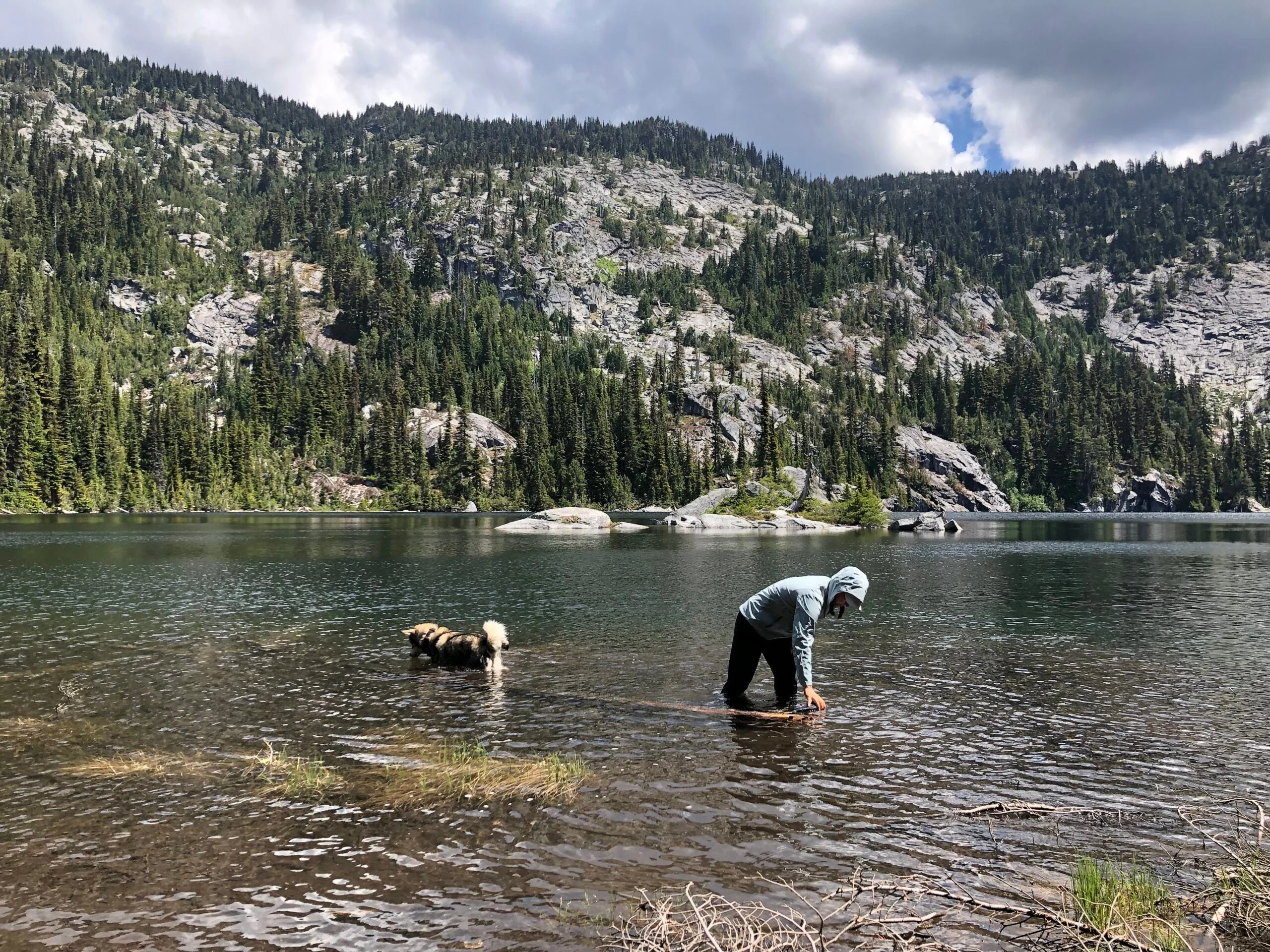
Filtering water in the Free Fly Cloudshield Rain Jacket at Tuck Lake in the Alpine Lake Wilderness of Washington. – Photo Credit: Whitlee Morris
What to Consider When Choosing a Rain Jacket
Types of Rain Jackets
I recommend that you always start by identifying a product’s intended use—and it’s no different when choosing the best rain jacket for you. Many of the jackets we covered in this review are very versatile, but there are designs best suited for specific activities and use cases.
Daily Use: Everyday rain jackets are for people living in high precipitation areas who may need to wear a rain jacket in their day-to-day life. Functional and comfortable, these jackets tend to have a high level of waterproof performance, are stylish, and have a relaxed fit to allow layering, but they aren’t always the most packable options.
Lightweight Shells: Most of the jackets on our list fall into this category and are suitable for activities like hiking and backpacking. While you can also use them as daily jackets, they prioritize lightweight materials that make them packable for any backcountry adventure. The price and performance of these jackets vary by brand and product design but you can often find great budget options.
Outdoor Performance: These jackets are geared towards performance while hiking, hunting, biking, and other outdoor activities, so they prioritize durable shell fabrics, ventilation, and other specialty features. Since many of these jackets are designed with the outdoors in mind, the pocket placement is often higher than on regular jackets to accommodate a hip belt on a backpack or, in some cases, a climbing harness. Many of these performance waterproof jackets are also suitable as winter shells for mountaineering or skiing.
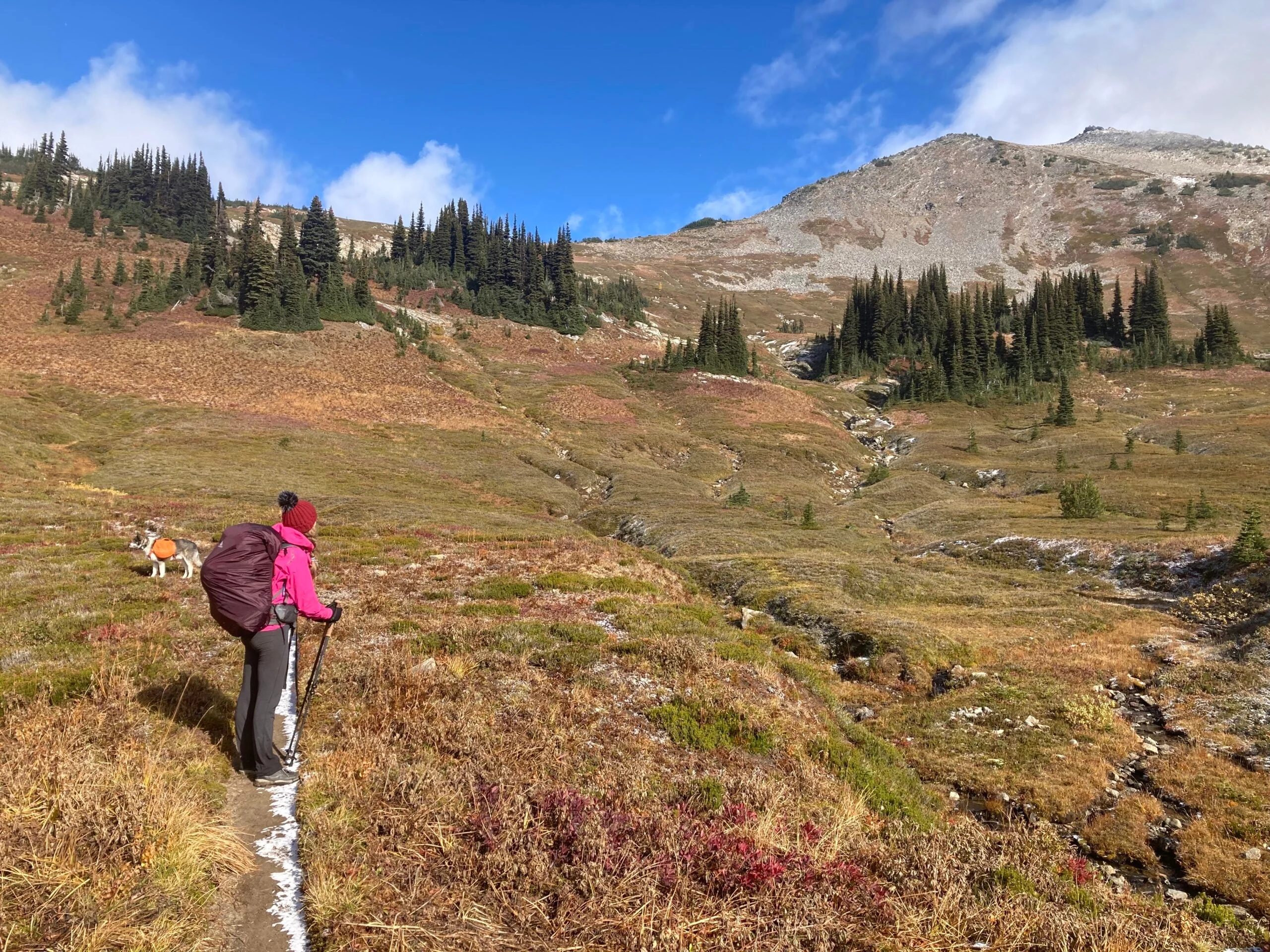
Testing rain jackets in the Glacier Peak Wilderness, Washington – Meg Carney
Materials and Waterproofing
Although some marketing may convince us that a rain jacket is 100% waterproof, no outdoor gear offers complete protection from moisture. Even the best rain jackets on our list have some flaws, and with enough time and use, the waterproofing may lessen. Note that there is a difference between waterproof and water-resistant. Many windbreakers and lightweight hiking jackets may offer some water resistance, but the jacket likely isn’t waterproof without a waterproof coating or liner.
Most manufacturers measure the waterproofness of the jacket materials by gauging how much water the fabric can be exposed to over 24 hours before failing. Most rain jackets have a minimum of 1,000 mm, but for a higher performing outdoor rain jacket, they’ll fall within the range of 5,000 to 30,000 mm.
5,000 mm: Anything less than this wouldn’t qualify as a technical outdoor rain jacket and likely has a lower level of performance beyond light rain showers.
5,000 – 10,000 mm: Ideal waterproof levels for light rain, snow, and sleet with minimal wind or pressure present.
10,000 – 15,000 mm: Decent waterproofness in various conditions but may lose effectiveness if fabric is put under pressure.
15,000 – 20,000 mm: Maintains waterproofing under heavy exposure to rain, snow, and other precipitation.
>20,000 mm: Maintains waterproofing under heavy exposure to rain, snow, and other precipitation and when put under pressure.
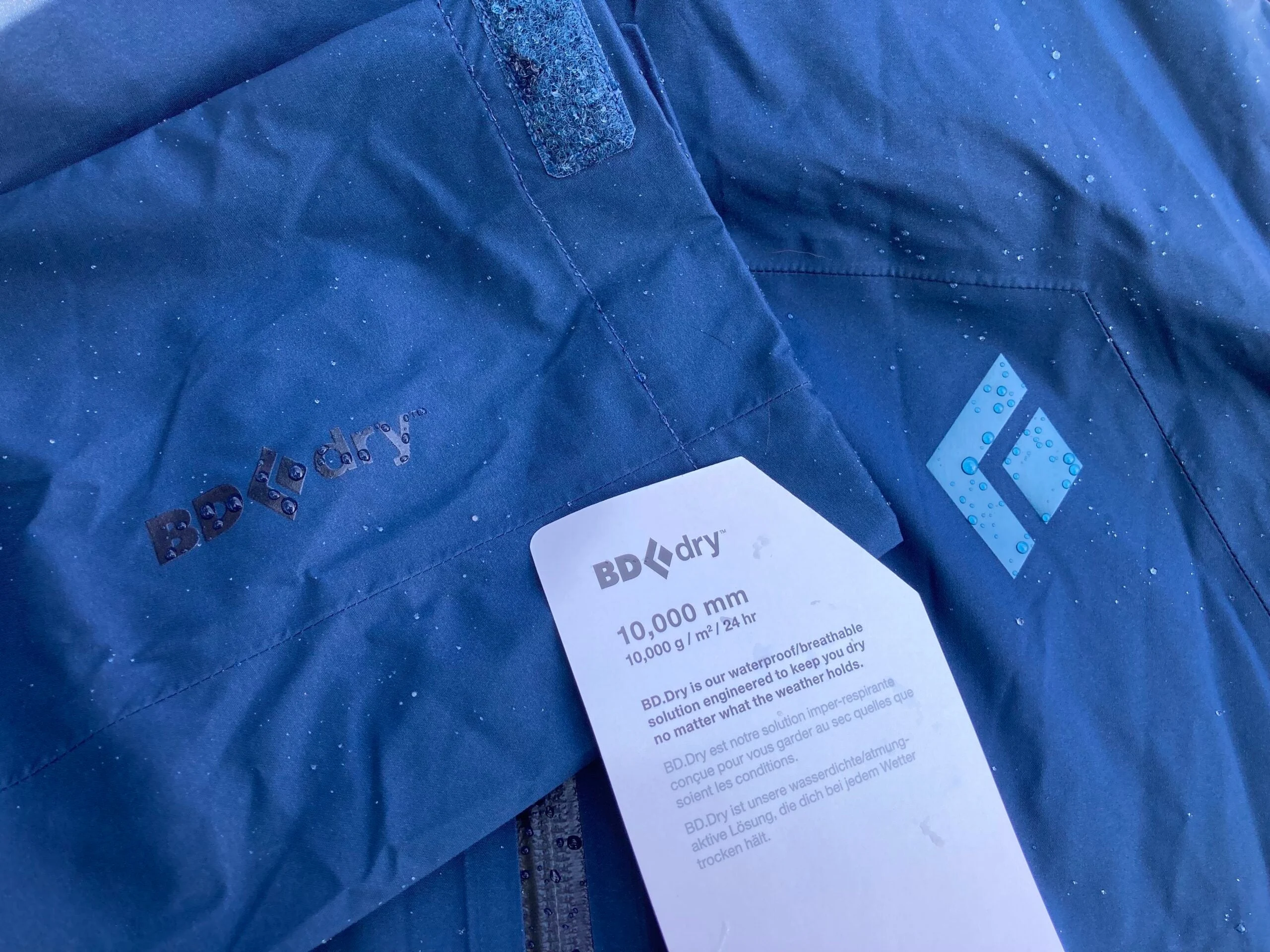
The Black Diamond Stormline Stretch Anorak Rain Shell utilizes a proprietary waterproof solution. – Meg Carney
Beyond the waterproof rating given to the jacket, take note of the waterproof membrane and coatings present. These membranes are necessary to keep moisture from penetrating the shell of the jacket material. There is a wide range of waterproof membrane options. A few of the most common you’ll see include:
ePTFE
Air Permeable
Gore-Tex
eVen
Polyurethane
Polartec NeoShell
Many brands utilize a proprietary membrane for their rain jackets, which may perform at a higher level because they’re designed to match the manufacturer’s direct guidelines and design intentions.
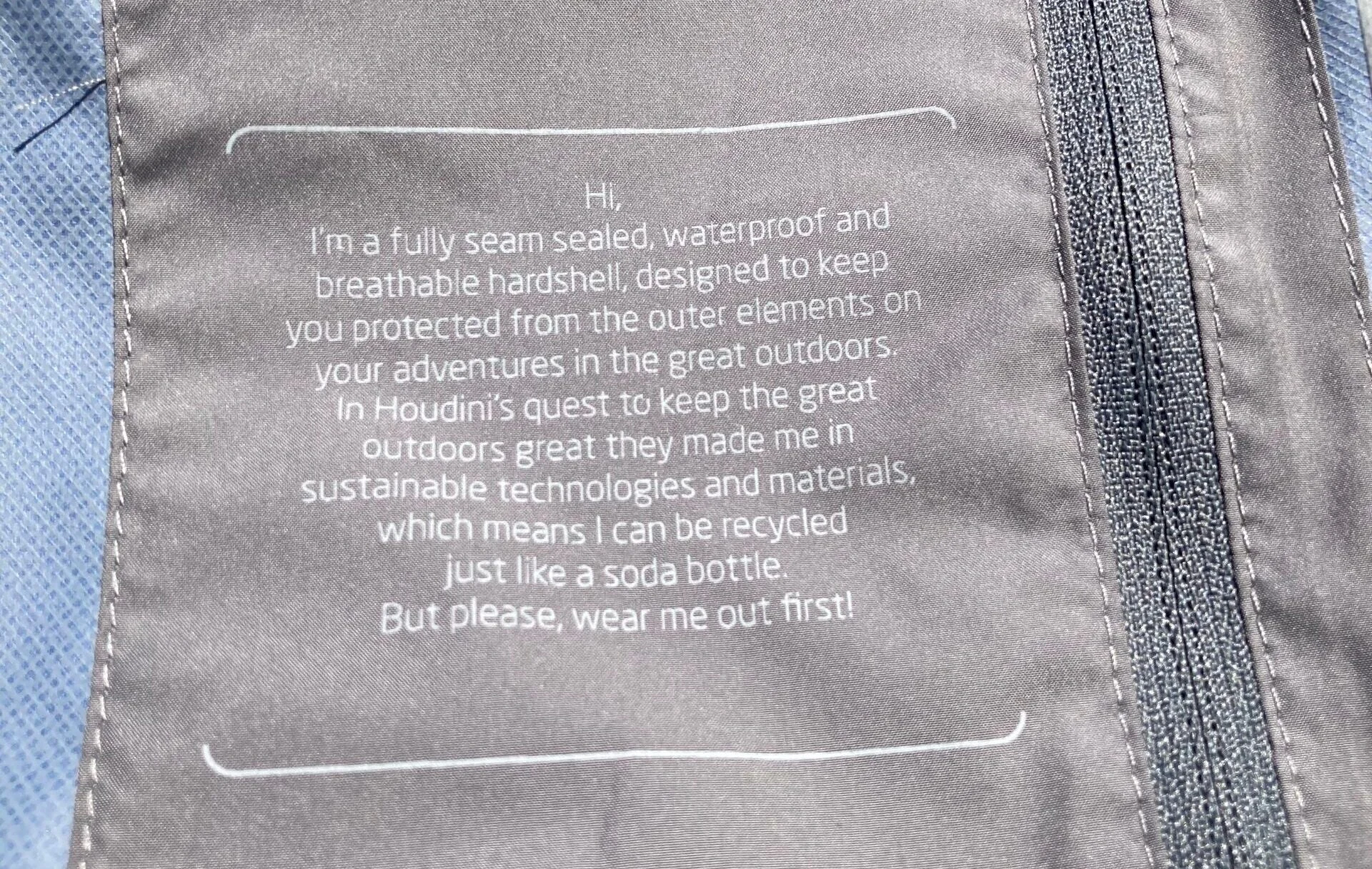
Part of why the Houdini BFF Rain Jacket won our best overall is the brand’s dedication to sustainability and creating a circular production model. – Meg Carney
Waterproof coatings—often a DWR (durable water repellent) coating or finish—are the next essential line of defense in rain gear. They prevent moisture from overwhelming the membrane and eventually leaching through the fabric to your skin. However, waterproofing may decrease the level of breathability, which is why proper ventilation options are necessary for comfort.
With new environmental guidelines and laws going into effect in the United States and other parts of the world, many companies are changing their approach to waterproof coatings. Traditionally, many rain jackets utilized PFCs and PFAS to maintain waterproofness. But these are made from harmful chemicals (perfluorocarbons and per-and poly-fluoroalkyl substances). Fortunately, many companies are phasing out these chemicals and opting for PFC and PFAS-free coatings.
Regardless of the type of coating, we’ve found that they all seem to wear off over time and lose some of their waterproof properties. Some water-based coatings have been proven to last longer than others, but most jackets will likely need re-waterproofing after a few seasons. You can easily do this with a PFAS-free waterproof coating product like Nikwax
.
Ventilation
Some rain jackets may be marked as “breathable.” Still, I prefer to look at jackets with ample ventilation to ensure more waterproof protection within the materials. Having a waterproof shell is of value, but if it isn’t ventilated, then as you sweat, you’ll get wet anyway.

Under arm zippers are a must-have for my favorite hiking rain jackets. – Meg Carney
If you are specifically concerned about breathability, look at the Moisture Vapor Transmission Rate (MVTR). This test analyzes how much perspiration can pass out of the jacket. Some brands may also utilize proprietary air-permeable waterproof membranes, but as mentioned above, these materials often compromise the waterproof properties. For high-intensity activities like hiking, it’s helpful to choose a MVTR breathability rating of 20,000 g/m² or higher.
Regardless of the breathability rating of the fabric, opting for a jacket with ample ventilation features is the best choice. Look for armpit zips, mesh-lined pockets, dual zippers, drawstring hoods/waist, and adjustable cuffs. All of these features give you more control over the level of ventilation available. I also consider how loosely the jacket fits. Having some room under the jacket is ideal for layering and also allows more air to pass through the openings, providing more ventilation. Of course, if the jacket fits too loosely, it can allow moisture in, so be aware of proper sizing and fit.

Another excellent ventilation feature some rain jackets provide is a dual zipper system. – Meg Carney
Weight and Packability
The weight of rain jackets can vary dramatically. Some heavier-duty rain jackets have a much higher weight and lower level of packability, but they tend to be more durable and waterproof. Lighter jackets may still offer a decent level of moisture protection, but in a smaller package that’s easier to fit into a backpack or commuter bag. On average, outdoor rain jackets tend to weigh between 9 to 16 ounces depending on the size and intended purpose of the jacket.

Most rain jackets designed for outdoor use roll up into the hood to a packable size. Others may feature a built-in stuff bag to stuff into a jacket pocket for even more compact packing options. – Meg Carney
Packability has a lot to do with weight and size, but many jackets offer additional hidden features to make them more packable. For instance, several brands offer a stuff sack-like design that allows you to stuff the jacket into one of the pockets and zip it shut. It’s a neat and tidy way to transport it—some ultralight rain jackets even pack down to the size of a coaster. Even if a jacket doesn’t pack down within its design, it may compress down easily, so all you need to do is roll the jacket into the hood.
Other Features
Choose a jacket with features that make sense for the activities you enjoy and your personal preference. For instance, if you’re looking for the lightest and most packable rain jacket, look for a design with minimal pockets to cut down on weight and fewer seams. That said, it’s nice to have a few well-placed pockets inside or outside the jacket for storage and ventilation.
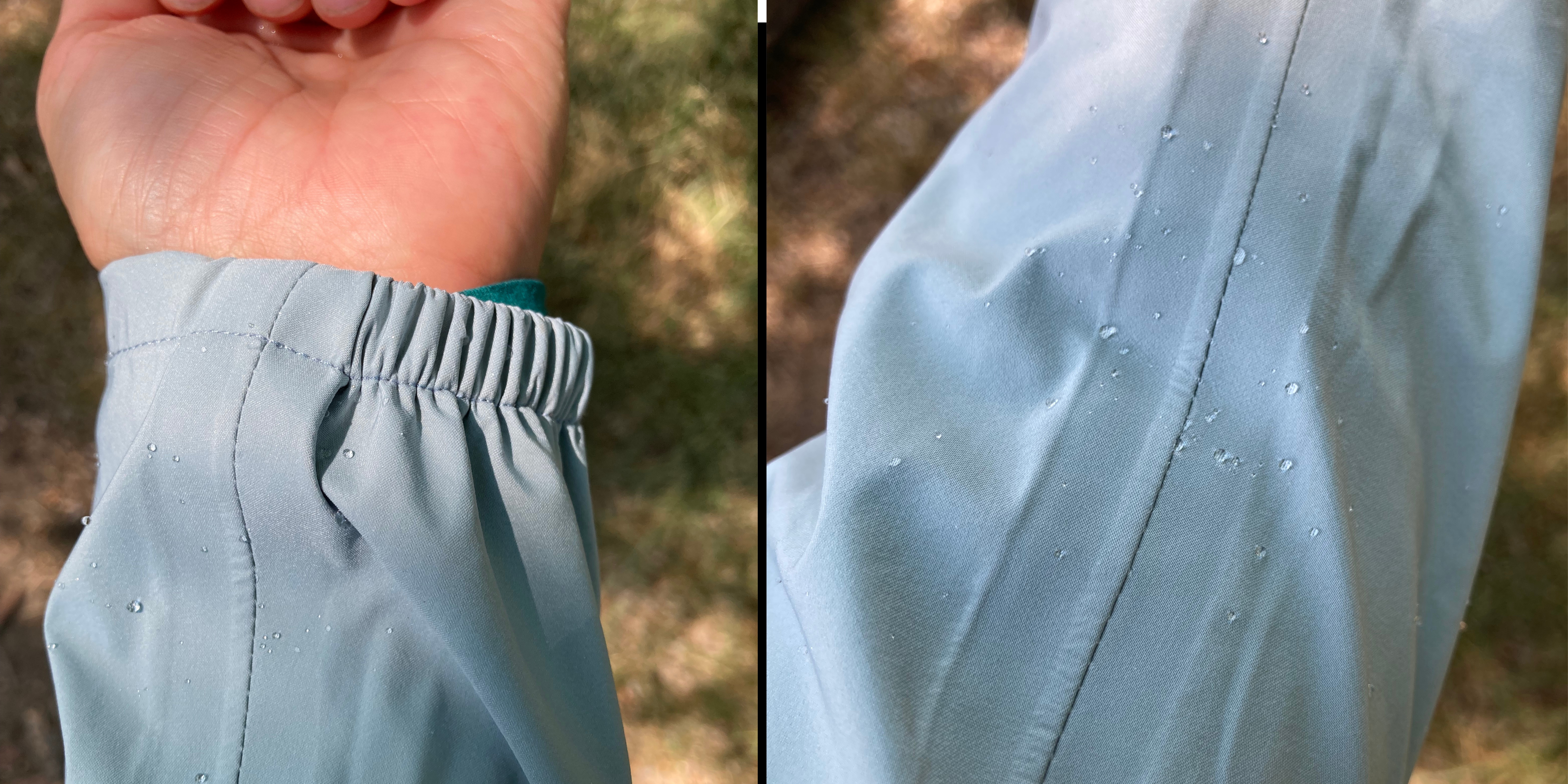
Sealed seams and some type of cuff adjustability help keep moisture out. – Meg Carney
If the jacket features pockets, they should close with a sealed zipper. The zipper may have a fabric flap or a waterproof zipper seal to ensure no moisture can easily penetrate the structure. Ventilation may be necessary for you, so in that case, also look for underarm zippers.
Any seams on the jacket should be sealed with seam tape or constructed to eliminate the seam and any gaps in the fabric. Some jacket designs may only seal certain seams to save on weight, but I’ve found this compromises waterproofing.
Next is the hood. In my opinion, no rain jacket is complete without a functional hood and many double as the stuff sack for jacket storage. The fit of the hood is very important. You want a hood that provides full protective coverage without inhibiting peripheral vision. It should be adjustable with a drawstring or cinch, either on each side of the hood near your neck or at the rear of the hood by the back of your head. These features help keep you dry and hold the hood in place on windy days. For some, the size of the hood may be a factor if you plan to wear a helmet or other protective headwear.
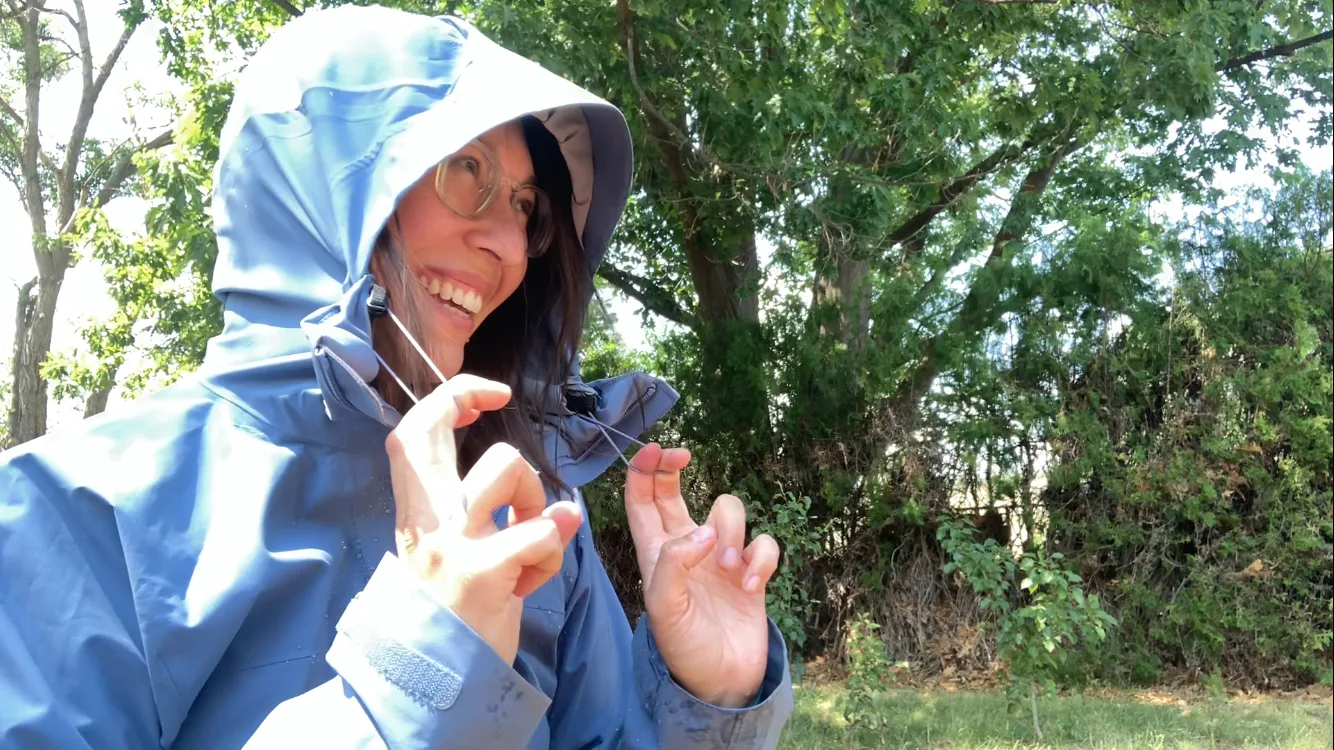
Features like a hood cinch are essential for changing weather conditions and comfort for the wearer. – Meg Carney
Another feature worth noting is whether the hood has a wire-stiffened brim. These brim designs prevent water from pooling or draining into the hood or neck of the jacket.
FAQ
Q: Are rain jackets completely waterproof?
Most rain jackets marketed as waterproof should be completely waterproof for at least a few months, if not years, depending on the frequency of use. If used in extreme weather regularly, the waterproofing on the jacket can wear off within 3 to 4 months. The type of waterproof materials used on the jacket materials can influence the longevity of the waterproofing, and no jacket will be waterproof forever. You can re-waterproof the materials
if you notice your jacket losing its waterproofing.
Q: Should a rain jacket be tight or loose?
The fit of a rain jacket should be loose enough for layering underneath but still snug enough that you can cinch it down as needed. A slightly looser fit can promote better insulation, as can additional features like pit zips, open cuffs, and pocket vents. If the jacket is too loose, cold air and moisture can get inside the jacket, defeating the purpose of wearing one, so having a proper fit and adjustability is ideal.
Q: Why do rain jackets have 2 zippers?
Most rain jackets opt for a two-zipper design to give you more temperature control. You can zip it up or down to your liking as the weather changes.
Q: Are rain jackets insulated?
There may be some insulated rain jackets, but most rain jackets are designed as shells as they’re typically meant to keep moisture out but still be breathable in warmer weather conditions. That said, rain jackets can provide warmth by trapping body heat, keeping you dry, and acting as a windbreaker. You can always wear an insulated jacket
underneath.
Q: Is there a breathable rain jacket?
I think the most waterproof rain jackets won’t offer much in terms of breathability. The more breathable they are, the more likely they will allow moisture into the jacket. Features like armpit zips, ventilated pockets, and dual zippers can increase breathability without compromising the jacket’s waterproofing. If the materials are marketed as breathable, they may become saturated with water more quickly than those designed to bead water off in a complete protective layer.
Best Rain Jackets: Final Thoughts

Testing rain jackets in Salem, MA – Meg Carney
Best Overall: Houdini BFF Jacket
Best for Hunting: Filson Swiftwater Rain Jacket
Best Lightweight: Outdoor Vitals Tushar Rain Jacket
Best Quarter Zip: Black Diamond Stormline Stretch Anorak Rain Shell
**Most Packable: Jack Wolfskin PreLight 2.5L Rain Jacket
**
Most Comfortable: Free Fly Cloudshield Rain Jacket
Across the board, the best rain jackets should keep you dry. While I personally think that a genuinely breathable rain jacket is a bit of a farce, having some level of ventilation is essential in a rain jacket utilized for activities like hunting or hiking. Looking into product materials, durability, and the type of waterproofing used in the jacket design is a good practice when choosing the right outerwear for your outdoor needs. While no jacket guarantees you’ll stay 100% dry, a good one can improve outdoor adventures, increase safety, and allow you to enjoy the day no matter the forecast.
Why Trust Us
For more than 125 years, Field & Stream has been providing readers with honest and authentic coverage of outdoor gear. Our writers and editors eat, sleep, and breathe the outdoors, and that passion comes through in our product reviews. You can count on F&S to keep you up to date on the best new gear. And when we write about a product—whether it’s a bass lure or a backpack—we cover the good and the bad, so you know exactly what to expect before you decide to make a purchase.

